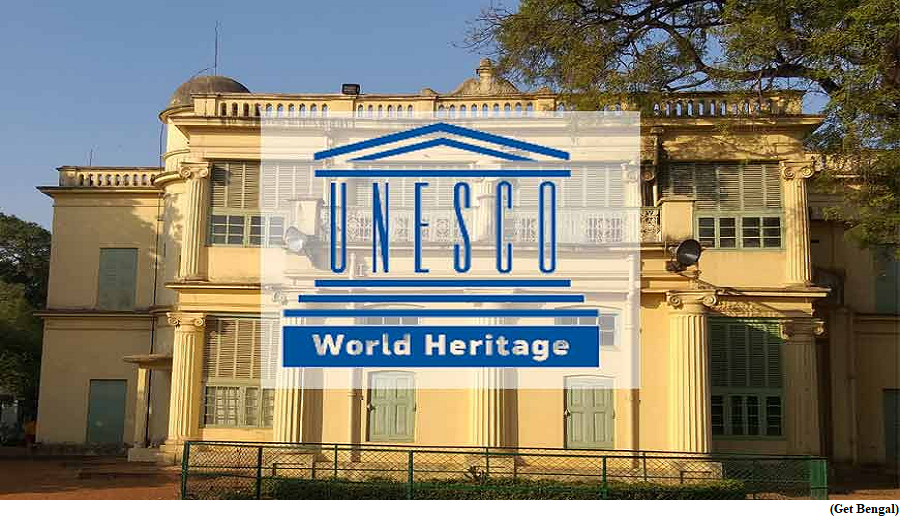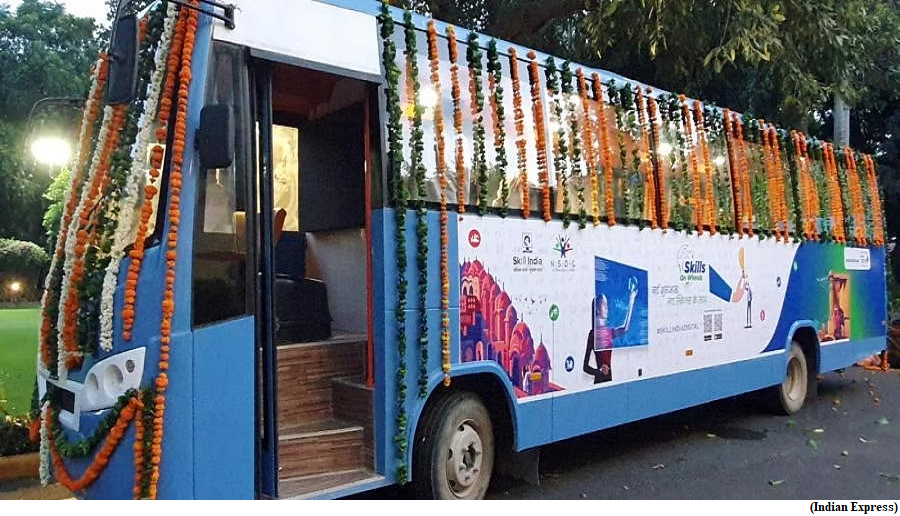Santiniketan finds its place on UNESCO’s World Heritage List (GS Paper 1, Culture)

Why in news?
- Santiniketan, a town established by Nobel laureate Rabindranath Tagore, made it to the UNESCO’s World Heritage List recently.
- Located in West Bengal’s Birbhum district, Santiniketan, which means “abode of peace”, started taking shape in 1901 and is the place where Tagore laid the foundations of Visva-Bharati University.
Facts:
- Santiniketan becomes the 41st UNESCO World Heritage Site in India and the third in West Bengal, after the Sundarbans National Park and the Darjeeling Mountain Railways.
- In 2022, the state’s Durga Puja got space in “Intangible Cultural Heritage of humanity” under UNESCO.
About Santiniketan:
- Established in 1901 by the Nobel Laureate, Santiniketan was a residential school and centre for art based on ancient Indian traditions and a vision of the unity of humanity transcending religious and cultural boundaries.
- A ‘world university’, Visva Bharati was established at Santiniketan in 1921.
Other sites to find place on the prestigious list recently include
- Ancient Jericho in Palestine;
- the Zarafshan-Karakum Corridor of Silk Roads in Tajikistan, Turkmenistan, Uzbekistan;
- the Gedeo Cultural Landscape in Ethiopia; and
- the Cultural Landscape of Old Tea Forests of the Jingmai Mountain in China’s Pu’er.
About UNESCO World Heritage Site:
- A World Heritage Site is a place that is listed by UNESCO for its special cultural or physical significance.
- The list of World Heritage Sites is maintained by the international ‘World Heritage Programme’, administered by the UNESCO World Heritage Committee.
- The UNESCO World Heritage Committee is composed of 21 UNESCO member states, elected by the General Assembly.
- The United Nations Educational, Scientific and Cultural Organization (UNESCO) seeks to encourage the identification, protection, and preservation of cultural and natural heritage around the world considered to be of outstanding value to humanity.
- This is embodied in an international treaty called the Convention concerning the Protection of the World Cultural and Natural Heritage, adopted by UNESCO in 1972.
‘Skills on Wheels’ initiative launched
(GS Paper 2, Governance)
Why in news?
- Recently, the Union Minister for Education and Skill Development & Entrepreneurship, launched ‘Skills on Wheels’ initiative with NSDC and IndusInd Bank with a flagging off ceremony.

Objective:
- The objective of Skills on Wheels is to enable a large number of youth to take up industry-relevant skill training that will improve their theoretical as well as practical knowledge and help them in securing a better livelihood by bringing necessary synergy, oversight, and effective coordination.
- It aims to bridge the gap between the skilled people required in the industry and the unemployed youth by ensuring that the right candidate with a passion for a particular job chooses the right course according to his/her academic background, aptitude, and skill set.
Key Highlights:
- Under the collaboration, a customized bus with retrofitted tools will promote the 'Skill India Mission’ initiative through 'Skills on Wheels' and will travel across the length and breadth of aspirational and backward districts.
- The initiative is aimed at spreading awareness at grass root level about free skill training programs enabling youth to profoundly change the trajectory of their lives through robust skill training.
- Aligned with this mission, this partnership with IndusInd Bank is aimed at empowering the youth of the nation through the ‘Skills on Wheels’ project.
Way Forward:
- Under the partnership, 60,000 youth will be empowered over a period of five years with the objective of improving livelihood of rural households by providing relevant skills training to its youth population.
ISRO's Aditya-L1 mission commences data collection with STEPS Instrument
(GS Paper 3, Science and Technology)
Why in news?
- The Indian Space Research Organisation (ISRO) announced recently that its Aditya-L1 mission has commenced collecting scientific data, marking a milestone in India's solar exploration efforts.

STEPS instrument:
- The Supra Thermal and Energetic Particle Spectrometer (STEPS) instrument, a part of the Aditya Solar Wind Particle EXperiment (ASPEX) payload, has started its data-gathering operations.
- STEPS, equipped with six sensors observing in various directions, is responsible for measuring supra-thermal and energetic ions ranging from 20 (kiloelectronvolt) keV/nucleon to 5 (mega electron volt) MeV/nucleon, as well as electrons exceeding 1 MeV.
- These measurements are essential for understanding the behaviour of particles around Earth, particularly in the presence of the Earth's magnetic field.
- These measurements will persist throughout the Aditya-L1 mission's cruise phase as it progresses toward the Sun-Earth L1 point, providing crucial insights into the origin, acceleration, and anisotropy of solar wind and space weather phenomena
Activations:
- The activation of STEPS took place on September 10, at a distance greater than 50,000 km from Earth, equivalent to over eight times the Earth's radius.
- After undergoing essential instrument health checks, data collection continued until the spacecraft moved beyond the 50,000 km mark from Earth.
Stakeholders:
- STEPS was developed by the Physical Research Laboratory (PRL) with support from the Space Application Centre (SAC) in Ahmedabad.
About Aditya-L1 spacecraft:
- The Aditya-L1 spacecraft, India's first mission dedicated to studying the Sun, has been making significant strides. It recently completed its fourth earth-bound manoeuvre, bringing it closer to its intended mission trajectory.
- The spacecraft lifted off successfully on September 2, carrying seven different payloads designed for a detailed study of the Sun.
- Four of these payloads will observe the Sun's light, while the other three will measure in-situ parameters related to plasma and magnetic fields.
What’s next?
- The next manoeuvre for the Aditya-L1 mission is scheduled for September 19.




